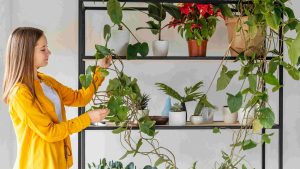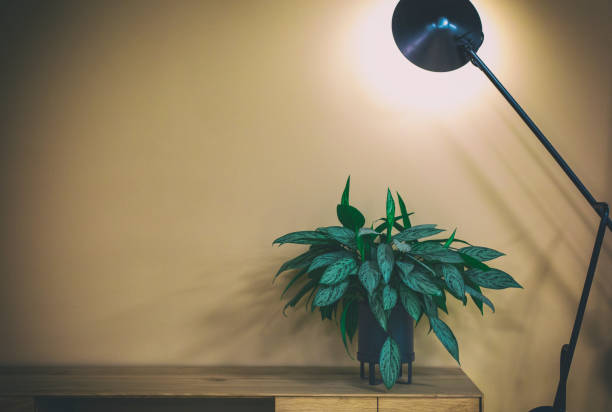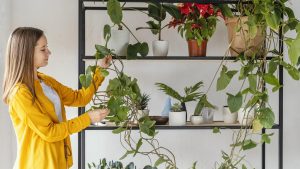Which grow light is best for your indoor plants? I had the same question when I started growing plants indoors. Natural sunlight is great, but it’s not always enough. That’s when I discovered the power of grow lights for indoor plants.
They help plants grow strong, even in dark rooms. But not all grow lights work the same way. Some are too dim, some get too hot, and some just don’t help plants at all. I’ve tried different types—LED, fluorescent, and full-spectrum lights.
In this guide, I’ll share what worked best for me. Whether you have leafy greens, flowers, or succulents, the right grow light can make a big difference. Let’s find the best one for your indoor garden!

The Best Grow Lights for Indoor Plants
The Ultimate Guide to Grow Lights: Boost Plant Growth Indoors
I love growing plants indoors, but good light is a challenge. Natural sunlight is not always enough, especially in winter. That’s why I tried different grow lights to help my plants thrive. Here’s what I learned from my experience.
1. Fluorescent Grow Lights (CFL & T5)
Fluorescent lights are budget-friendly and work well for small plants. I used compact fluorescent lights (CFLs) for my herbs and seedlings. They don’t use much energy and stay cool, so I placed them close to my plants.
- Pros: Affordable, easy to find, and low heat.
- Cons: Not strong enough for large or flowering plants.
2. LED Grow Lights
LEDs are my favorite because they save energy and last long. They produce the right mix of blue and red light, which plants love. I used full-spectrum LED panels for my vegetables, and they grew faster.
- Pros: Energy-efficient, long-lasting, and produce little heat.
- Cons: Some models are expensive.
3. High-Intensity Discharge (HID) Lights
HID lights are powerful and great for big plants. They include Metal Halide (MH) and High-Pressure Sodium (HPS) bulbs. I tried them for tomatoes, and the results were amazing. But they got hot, so I needed a fan.
- Pros: Best for large plants, very bright.
- Cons: Expensive and produces a lot of heat.
4. Incandescent Grow Lights
Incandescent bulbs are cheap, but they don’t work well. I tried them for a small plant, but they produced too much heat. My plant’s leaves burned, so I stopped using them.
- Pros: Cheap and easy to find.
- Cons: Too much heat, not energy-efficient.

Choosing the Right Grow Light
I wanted to grow plants indoors, but I faced a problem. My plants did not get enough sunlight inside my home. I needed a good grow light to keep them healthy. After a lot of research and testing, I found the best one for my needs. Here is what I learned while choosing the right grow light.
Understanding Grow Lights
Grow lights help indoor plants get the light they need. Natural sunlight has all the colors that plants use to grow. When growing indoors, I needed a light that could replace the sun. There are many types of grow lights, and choosing the right one is important.
Light Spectrum Matters
Plants need different colors of light to grow properly. I learned that blue light helps leaves grow strong. Red light helps flowers and fruits develop. A full-spectrum grow light is the best choice. It provides all the colors that plants need. I chose an LED grow light with both blue and red lights.
Wattage and Coverage Area
I had to think about how much space my plants needed. A small light is fine for a few plants, but larger areas need stronger lights. I checked the wattage of each grow light. More watts mean a stronger light. I also looked at the coverage area of each light. My LED grow light covered all my plants well.
Heat and Ventilation
Some grow lights produce a lot of heat. Too much heat can burn plants. I placed my light at the right distance to avoid damage. I also made sure there was good airflow in the room. This kept my plants from overheating.
Energy Efficiency and Lifespan
Electricity costs money, so I wanted an energy-efficient light. LEDs use less electricity than other types of lights. They also last for many years. I chose an LED light because it saved me money in the long run.
Ease of Setup and Use
Some grow lights are hard to install. I wanted something simple. I picked a light that I could hang above my plants. It had an easy on/off switch and adjustable height. This made it easy to use.
Cost vs. Benefits
I set a budget before buying a grow light. Cheap lights do not always work well. Expensive lights are great, but they cost a lot. I balanced quality and price to get the best value. My LED light was a bit costly, but it was worth it.
Tips for Using Grow Lights
I have been using grow lights for a while now. They help my plants grow strong and healthy indoors. I have learned a lot through trial and error. Here are my tips to get the best results.
1. Choose the Right Grow Light
The right grow light makes all the difference. Not all lights work well for every plant.
- LED lights last long and save energy.
- Fluorescent lights work well for small plants and seedlings.
- HID lights are very strong but produce a lot of heat.
2. Understand the Light Spectrum
Plants need different light colors to grow well. I use full-spectrum lights for the best results.
- Blue light helps leaves grow.
- Red light encourages flowers and fruit.
- Full-spectrum light covers all growth stages.
3. Set the Right Light Distance
Placing the light too close to plants burns them. Too far, and they don’t grow well.
- LED lights should be 12-24 inches from plants.
- Fluorescent lights work best 6-12 inches away.
- HID lights need to be at least 24 inches away.
4. Control Light Duration
Plants need rest, just like people. I follow a schedule to avoid stress.
- Vegetables need 14-16 hours of light daily.
- Flowers do well with 12 hours of light.
- Seedlings need up to 18 hours for fast growth.
5. Avoid Overheating
Too much heat can dry out plants. I checked the temperature often.
- Keep the grow space 65-75°F during the day.
- At night, keep it around 60-65°F.
- Use a fan to prevent hot spots.
6. Rotate Plants for Even Growth
Plants lean toward the light. I rotate them to keep them straight.
- Turn plants every few days.
- This helps them grow evenly.
7. Use Reflective Surfaces
Light can be wasted if it spreads too much. I use reflective materials to make sure all light reaches the plants.
- I place aluminum foil around my growing space.
- I use white walls or mylar sheets to reflect light.
8. Keep Lights Clean
Dust can block light. I clean my bulbs and fixtures often.
- I wipe the lights with a dry cloth every week.
- I remove dust to keep the brightness strong.
9. Monitor Plant Health
Too much or too little light causes problems. I watch my plants closely.
- Yellow leaves mean too much light.
- Leggy plants need more light.
- Brown tips may mean heat damage.
10. Use a Timer
I set a timer so I don’t forget to turn the lights on or off.
- Timers keep my plants on a steady schedule.
- This prevents stress and stunted growth.
11. Adjust as Plants Grow
Plants change as they grow. I adjust the light height and duration when needed.
- Taller plants need lights moved higher.
- Flowering plants may need extra red light.
12. Provide Darkness
Plants need darkness to rest and grow properly. I don’t keep the lights on all the time.
- Most plants need at least 6 hours of darkness.
- 24-hour light can stress and weaken them.
13. Group Similar Plants Together
Different plants have different light needs. I grouped them based on their needs.
- Leafy greens need less light than flowering plants.
- Herbs and seedlings thrive under moderate light.
14. Watch for Signs of Stress
Plants show signs when something is wrong. I fix problems early.
- Wilting means too much heat or not enough water.
- Pale leaves do not have enough light.
- Brown edges mean the lights are too close.
15. Choose the Right Bulb Wattage
Higher wattage doesn’t always mean better growth. I pick bulbs based on plant type.
- Seedlings do well with 20-40 watts per square foot.
- Mature plants need 50-60 watts per square foot.
16. Keep Air Circulating
Airflow prevents mold and heat buildup. I always keep a fan nearby.
- Fans prevent overheating.
- They strengthen plant stems by mimicking wind.
17. Consider Cost and Energy Use
Some lights use more electricity. I pick lights that save energy.
- LEDs cost more upfront but save money in the long run.
- Fluorescents are cheaper but need replacing more often.
18. Use Different Lights for Different Growth Stages
Seedlings, growing plants, and flowering plants need different light settings. I switch my lights as needed.
- Seedlings need cool blue light.
- Growing plants need balanced, full-spectrum light.
- Flowering plants need warm red light.
19. Maintain Proper Humidity
Too much or too little humidity affects plant growth. I check humidity levels daily.
- 50-70% humidity is best for most plants.
- Use a humidifier or dehumidifier if needed.
20. Keep a Growth Journal
I write down light settings and plant progress. This helps me learn what works best.
- I track light hours, growth speed, and plant health.
- If something goes wrong, I check my notes for answers.
My Favorite Grow Lights
After testing different options, I found a few that work best.
- GE BR30 Full Spectrum LED – This bulb is Perfect for houseplants, energy-efficient, and affordable.
- Spider Farmer SF-1000 LED – Best for vegetables and herbs; great light spectrum.
- Sun System HPS Grow Light – Ideal for flowering plants, very bright.
- Vivosun T5 Fluorescent – Budget-friendly choice for seedlings and greens.

Final Thoughts
Grow lights have helped my plants thrive indoors. By choosing the right lights and adjusting settings, I see better growth. A little effort goes a long way in keeping plants happy. With these tips, anyone can grow healthy plants indoors!
FAQ
The Best Grow Lights for Indoor Plants
LED grow lights provide bright, energy-efficient light for plant growth. They mimic sunlight and help plants grow strong indoors.
How to choose the best grow lights for indoor plants
Pick full-spectrum LED lights for the best plant growth. Ensure they have the right brightness and coverage for your plants.
Best grow lights for indoor plants UK
In the UK, LED grow lights with adjustable settings work best. Brands like Spider Farmer and Mars Hydro are popular choices.
Best grow lights for indoor plants Reddit
Reddit users recommend full-spectrum LEDs like Mars Hydro and Viparspectra. They suggest choosing lights based on plant type and growth stage.
Best grow lights for indoor plants Amazon
Amazon offers top-rated LED grow lights like GE and Spider Farmer. Check reviews and choose a light that fits your plant’s needs.
Best grow lights for indoor plants in winter
Use high-intensity LED grow lights to replace natural sunlight in winter. Adjustable spectrum lights help plants grow even with less daylight.
Best grow lights for indoor plants Australia
In Australia, full-spectrum LED grow lights work best for indoor plants. Brands like Viparspectra and Spider Farmer are widely recommended.
Best grow lights for indoor plants nearby
Check garden centers, home improvement stores, or online marketplaces. Local stores often have LED grow lights suited for your area.
Best grow lights for indoor plants Wirecutter
Wirecutter recommends LED grow lights from brands like GE and Barrina. They focus on energy efficiency, brightness, and plant growth results.
Best grow lights for indoor plants Walmart
Walmart sells affordable LED grow lights from brands like Feit Electric. Look for full-spectrum options to help plants grow indoors.


